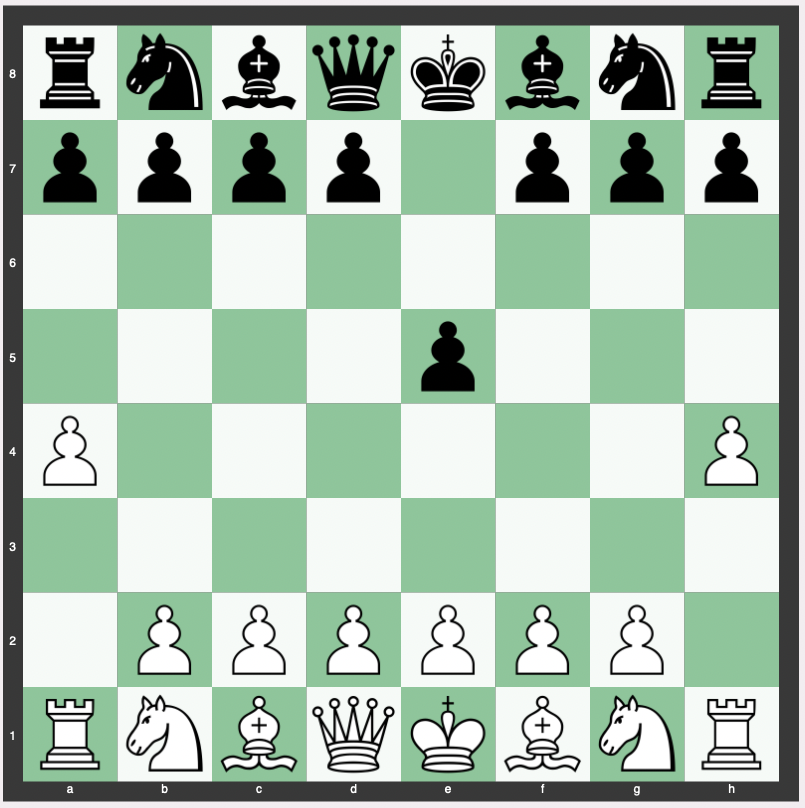The Crab Opening, known for its unique and unorthodox approach, involves forming what is often referred to as “crab pincers” with pawns on a4 and h4.
This opening draws its name from the characteristic structure that resembles a crab’s pincers and has become an intriguing part of chess theory.
We look at the various facets of the Crab Opening, its strategic implications, its history, and its relevance in different levels of play.
Move Order of the Crab Opening
The Crab Variation commences with the moves 1.a4 e5, as Black makes an immediate attempt to control the center with 1…e5.
Following up, White plays 2.h4, making another unconventional flank pawn move.

Together, these moves prepare to fianchetto the rook’s bishop, thus forming the “crab pincers.”
Theory, Strategy, and Purpose of the Crab Opening
The primary goal behind the Crab Variation is to sidestep conventional opening theory.
This allows White to set the game into less familiar territory, often surprising the opponent.
By developing on the flanks, White aims to disrupt traditional center-focused strategies.
The idea is to unbalance the game, leading to unconventional and complex positions.
These unique positions require creative and strategic play from both sides, often leading to fascinating and non-standard games.
Variations of the Crab Opening
Although the Crab Opening may seem inflexible, there are several variations and responses that can be employed by both White and Black.
These can range from aggressive attempts to exploit the unconventional opening to more conservative plays that adhere to classical principles.
Both sides must be prepared to adapt to various tactics and strategies as the game evolves.
Evaluation of the Crab Opening
The evaluation of the Crab Opening is -1.40.
Sample Continuation Lines of the Crab Opening
Continuation lines of the Crab Opening include:
2… d5 3. e3 Nf6 4. d4 Nc6 5. dxe5 Nxe5
2… d5 3. d3 Nc6 4. c3 Nf6 5. g3 h6 6. Bg2 a5 7. Nf3 Bc5 8. d4 Ba7 9. Nxe5 Nxe5
2… d5 3. g3 Nf6 4. Bg2 Nc6 5. d3 h6 6. Nf3 Be6 7. c3 Bd6 8. O-O O-O 9. Na3 Qd7 10. Nb5 Be7 11. Na3 Rad8 12. b4
2… Nf6 3. g3 d5 4. d3 Nc6 5. c3 Be6 6. Bg2 h6 7. Nf3 Qd7 8. Na3 Rd8 9. b4 Bd6 10. Nb5 Be7 11. d4 e4 12. Ne5 Nxe5 13. dxe5
History of the Crab Opening
The Crab Opening, while not part of mainstream chess theory, has a storied and interesting history.
It has been played by various players at different levels, including some renowned Grandmasters.
The opening has often been used as a surprise weapon to catch opponents off guard, particularly in rapid and blitz formats.
Is the Crab Opening Good for Beginners or Intermediates?
The Crab Opening’s unconventional nature might make it an appealing option for intermediate players looking to explore new strategic avenues.
However, beginners might find the complexity and non-standard positions challenging.
Understanding the underlying principles of the Crab Opening requires a certain level of chess understanding and creativity.
How Often Is the Crab Opening Played at the Grandmaster Level?
The Crab Opening is rarely seen at the Grandmaster level, particularly in classical chess.
Its unconventional nature makes it less appealing in high-stakes games where established theory tends to dominate.
However, it has been used occasionally as a surprise weapon, especially in shorter time controls where the shock value can be more pronounced.
Don’t Mess with the Crab Opening
Conclusion
The Crab Opening, with its unusual move order and strategic implications, offers a unique and fascinating dimension to the game of chess.
While not commonly seen at the highest levels of play, it embodies a spirit of creativity and unorthodoxy that can be appealing to those looking to explore non-traditional paths.
Whether used as a surprise weapon or a means to foster creativity, the Crab Opening serves as a testament to the rich and diverse landscape of chess openings, where even the most unconventional ideas can find a place.


